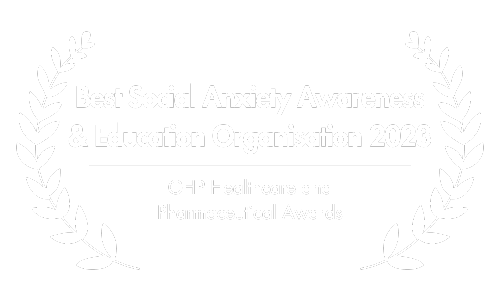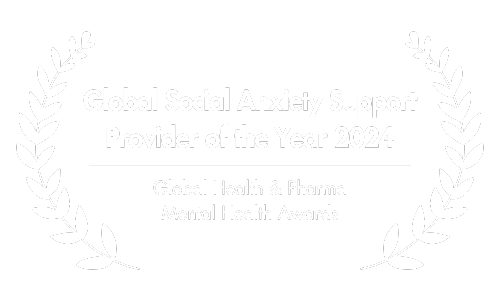Social Anxiety Explained
What Is Social Anxiety?
Social anxiety refers to excessive concerns about being negatively evaluated and generating an undesired impression on others.
People with a strong desire to be seen in a specific way, but who simultaneously lack confidence in their ability to generate that desired impression, experience anxiety and fear before and during social situations.
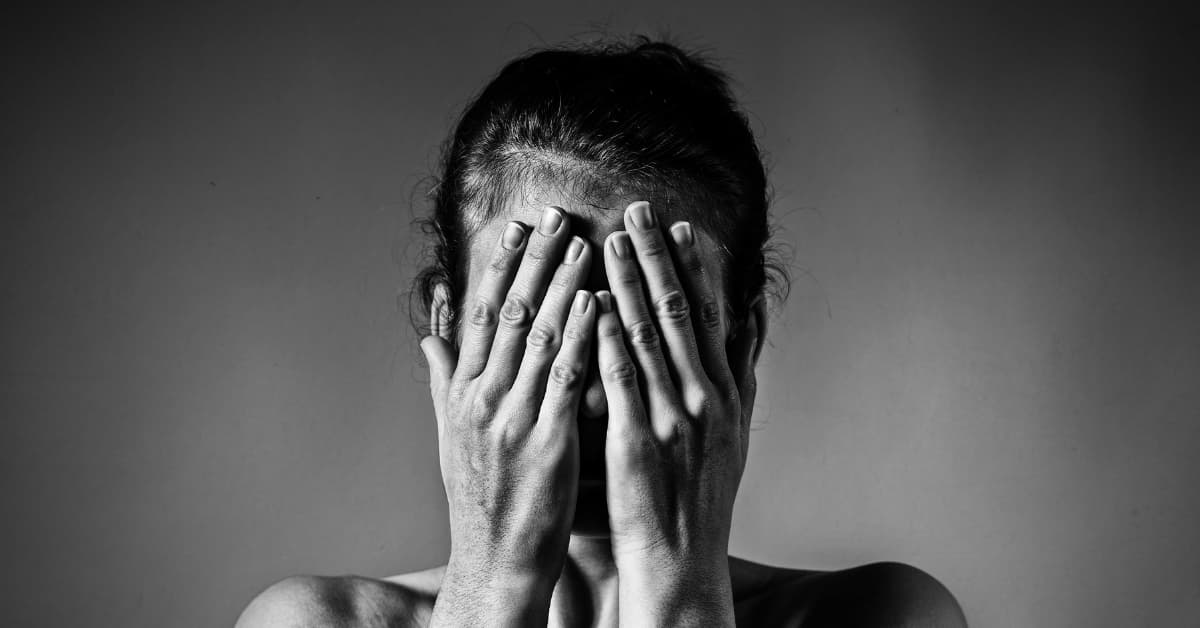
Social anxiety in lower intensities is viewed as an adaptive trait. By being somewhat concerned about the impression we make on others, we are motivated to act in ways which improve our chances of being an accepted and valued member of our community.
As social anxiety becomes more prominent, these benefits subside. Being too concerned about what other people may think of us usually leads to decreased social performance.
We are too anxious and aroused to do well in the social realm.
What Is Social Anxiety Disorder?
Once our concerns of being negatively evaluated pass a certain threshold, we start speaking of social anxiety disorder (also: SAD). If a person’s quality of life is drastically impacted by their social fears, they may meet the diagnostic criteria for this psychological condition.
At this point, affected people either experience severe distress when facing the feared social situations or they avoid them altogether.

While some people may struggle with specific settings, such as public speaking anxiety, others may fear virtually all social encounters.
While some people with social anxiety disorder are primarily concerned with seeming weird or inept, others worry about displaying physical symptoms of anxiety, or the possibility of offending others.
Despite these differences, the common denominator of people with SAD is the fear of making an undesired impression.
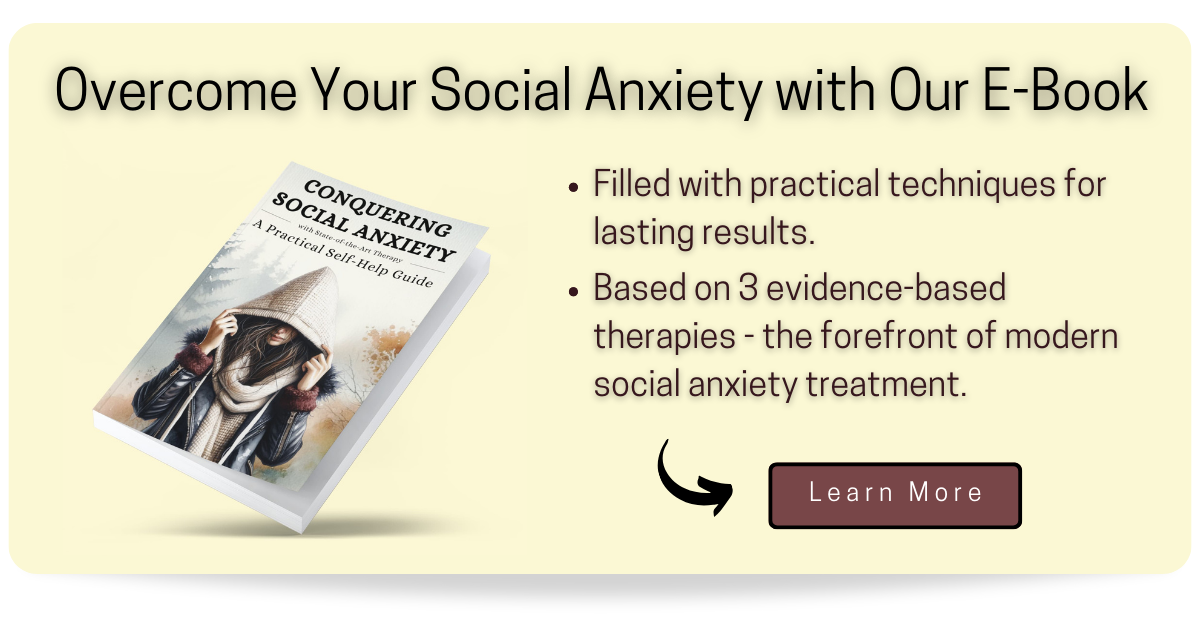
Social Anxiety Definition
According to the Anxiety and Depression Association of America (n.d.), “the defining feature of social anxiety disorder, also called social phobia, is intense anxiety or fear of being judged, negatively evaluated, or rejected in a social or performance situation.“
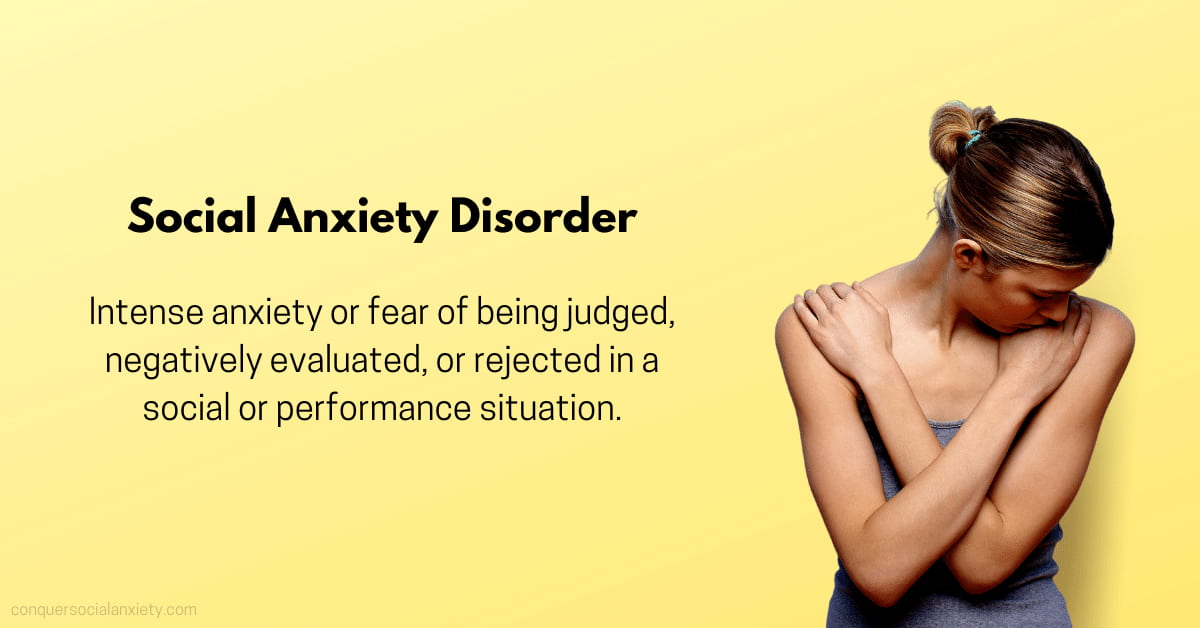
As you can see, this definition emphasizes that the concerns relate to possible scrutiny by others in social situations.
This characteristic draws the line between social anxiety disorder and similar psychological conditions, such as panic disorder.
While panic attacks may occur in both cases, people with panic disorder are mainly concerned about their health and a general loss of control when experiencing them. People with social anxiety disorder are mainly concerned about what others may think of them when having a panic attack.
Social Anxiety Versus Shyness
While they do overlap significantly in terms of traits and people that experience them, shyness and social anxiety are not the same thing.
You can be shy but do not suffer from social anxiety. Likewise, you can suffer from social anxiety and not be shy.
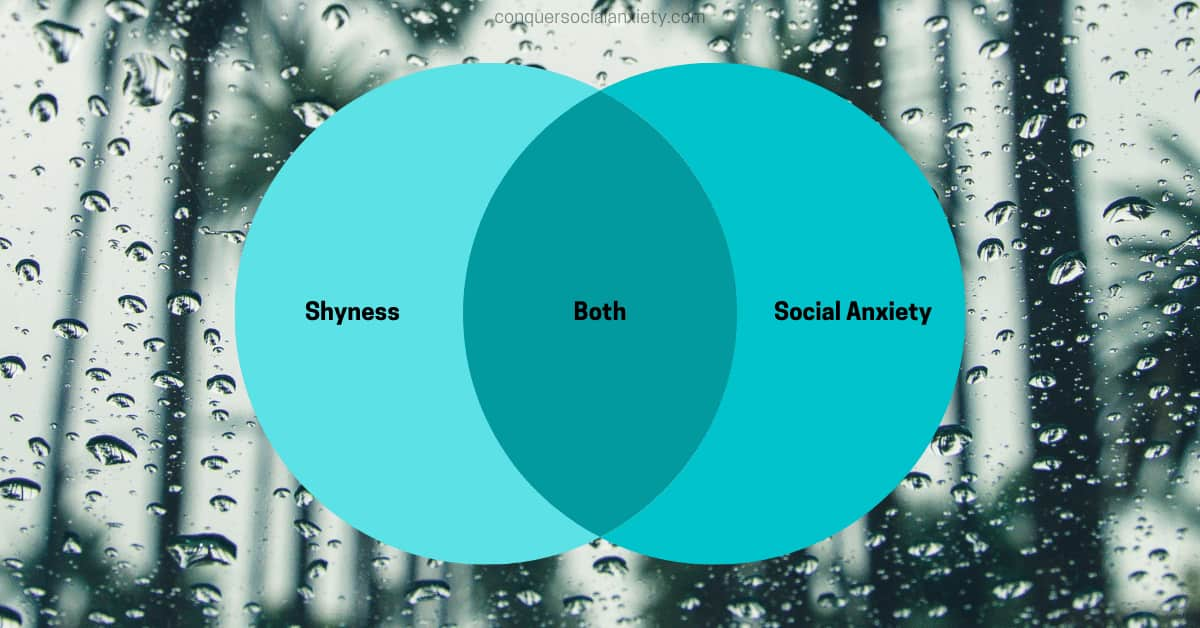
There are shy people who do not refrain from living their life and pursuing their goals. Their quality of life is not drastically impacted by their social fears.
There are people with social anxiety who are extroverted and outgoing. They may struggle with specific social settings, such as public speaking anxiety, but not with shyness.
However, many shy people experience social anxiety, and many socially anxious people are shy.
Social Anxiety Versus Social Phobia
The terms social anxiety disorder and social phobia are often used interchangeably. This indicates that SAD is a certain type of phobia.
The American Psychiatric Association (2013) defines specific phobias as exaggerated, intense fears of certain things, situations and even places. In the case of social anxiety the fear is related to social settings.
People with social phobia mostly recognize that their anxiety is out of proportion and have a hard time understanding their intense fear in certain social settings.
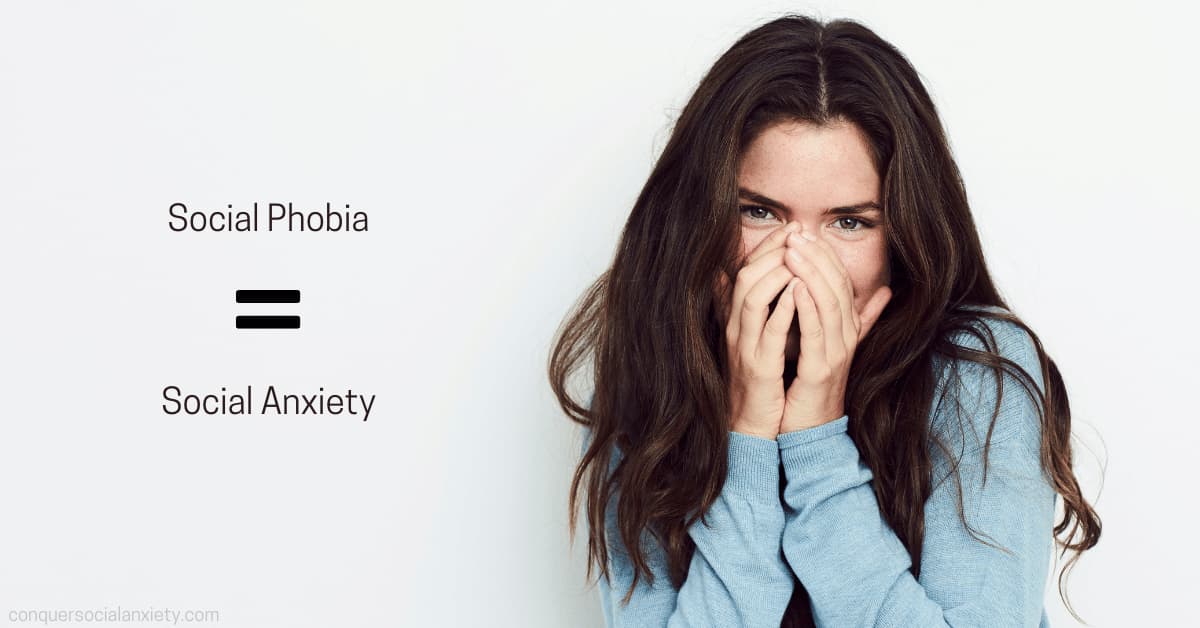
Telling a person with social anxiety that there is no reason to be afraid around other people is just like telling a person with arachnophobia that spiders won’t harm her. Affected people understand that their emotional reaction may be exaggerated, but can’t seem to control it.
While originally named social phobia, the term is not really applied anymore and has been officially replaced with social anxiety disorder.
How to Explain Social Anxiety?
Why do people experience anxiety in social situations although there is no objective, imminent threat?
Various research teams and experts have proposed different theories. They all point towards the same direction.
A person craves a specific social outcome (usually making a certain impression) but sees little chances in succeeding to generate it. What is more, they presume that the impression they generate is the exact opposite of what they want.
The discrepancy between the desired outcome and the expected outcome is believed to be the driving force of social anxiety. Like this, lot is on the line in social situations. Anxiety, fear and high arousal follow.
We have summarized the most commonly accepted explanations in the following table.
| Explanatory Model | Desired Outcome | Expected Outcome |
|---|---|---|
| #1 Clark & Wells (1995) | To generate a positive impression of the self on others (often high standards for the self). | Little confidence in one’s ability to do so successfully |
| #2 Rapee & Heimberg (1997) | Meet others’ expectations, which are believed to be very high. | The presentation of the self as seen by others is imagined to be negative. |
| #3 Gilbert (2001) | Fulfil the requirements necessary to gain / maintain social status (believed to be very high). | Little confidence in one’s ability to meet these requirements. |
| #4 Moscovitch (2009) | Meet society’s expectations of the self, which are believed to be very high. | The self is perceived as deficient & flawed. |
Causes of Social Anxiety Disorder
As it is the case for most psychological conditions, there is no single root cause of social anxiety disorder.
Biological, psychological, and socio-economic factors can all contribute to its development. As these predispositions combine, chances of suffering from social anxiety increase.
The following list summarizes the state-of-the-science regarding the causes of social anxiety:
- Genetics
- Insecure Attachment Style
- Parents’ Shortcomings
- Traumatic Social Experiences (Direct Conditioning)
- Witnessing Other’s Traumatic Social Experiences (Vicarious Conditioning)
- Significant Negative Life Events (Depressed Parent, Being Abused, etc.)
- Social Skills Deficit
- Cognitive Biases (Unfavorable Ways of Thinking)
- Biological Vulnerabilities
- Cultural Influences
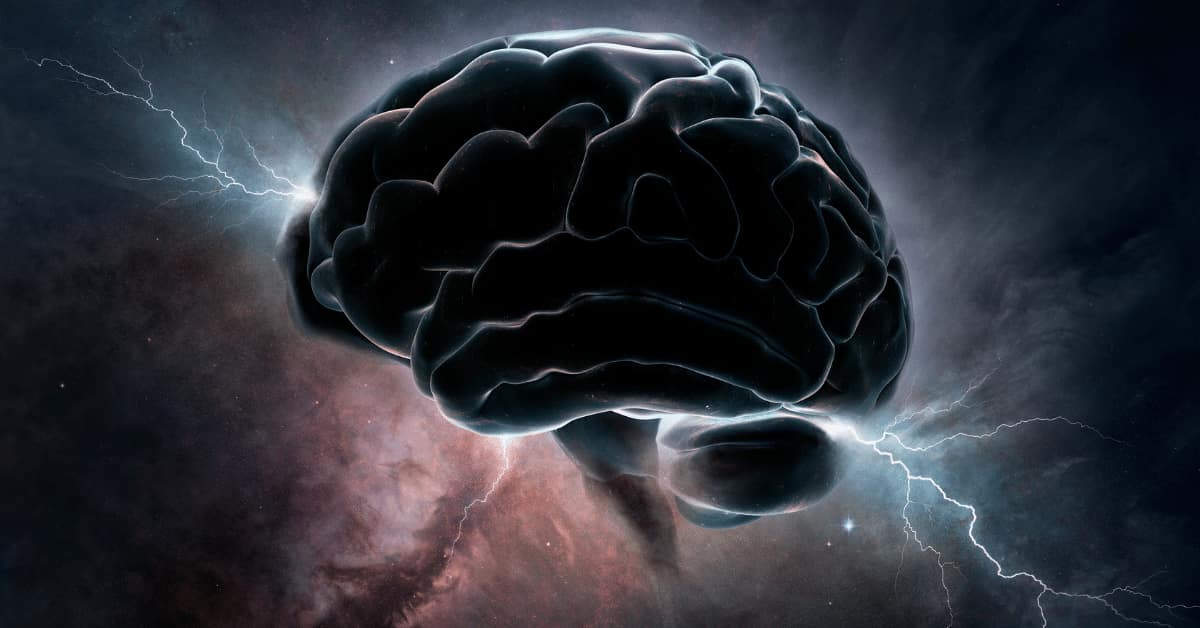
Note that psychological conditions are usually highly idiosyncratic, meaning that they are the result of unique experiences, made in a unique environment, with unique genes and biological traits. Their causes cannot be generalized.
Anxiety in Social Situations: The Most Commonly Feared Scenarios
As pointed out before, the concerns about being negatively evaluated by others can differ widely from one person to another.
While some people fear participating in larger groups, others are especially afraid of being in a situation with just one other person.
An individual may be afraid of taking classes in an academic environment, but is totally fine with going on a private date with an unknown person.

Likewise, someone afraid of dating may feel completely comfortable speaking up in a larger group.
The following list depicts the most commonly feared situations of people with social anxiety:
- Public Speaking
- Being the Center of Attention
- Direct Eye-Contact
- Eating & Drinking in Public
- Writing While Being Observed
- Having Sex
- Being Criticized
- Talking to Authority Figures
- Performing in Front of Others
- Paying in Public
- Using Public Restrooms
- Reading Out Loud to Others
- Parties
- Dating
- Meeting Strangers
- Engaging in Smalltalk
- Displaying Physical Anxiety Symptoms in Front of Others
- Initiating Conversations
These are just the most common examples. A socially anxious person may fear any situation in which they may be judged or evaluated by others.
Depending on the particular situations a person fears, their quality of life may be impacted greatly. Those who fear participating in larger groups might refrain from pursuing higher education and settle with a job below their potential and capabilities.

The Most Common Physical Symptoms of Social Anxiety
Social anxiety does not only produce symptoms on a cognitive, but also on a physical level. The bodily manifestations of anxiety can become a main concern for many socially anxious people.
The number one concern of someone with public speaking anxiety may be a shaky voice or shortness of breath.
Others may worry about blushing when being the center of attention (erythrophobia) or about excessive sweating (hiperhydrosis).

Although the physical symptoms of social anxiety can be regarded a secondary manifestation of SAD, in many cases they end up being the primary concern of the individual.
For example, someone might be afraid of making a spelling mistake while giving a speech. This leads to intense anxiety, which in turn leads to a racing and pounding heart.
Now the person is afraid that the audience might notice her nervousness by displaying physical symptoms, such as a shaky voice, sweaty armpits, or shortness of breath.
In cases like these, affected people are ashamed of their physical symptoms of anxiety and can become obsessed with controlling them.
Like this, a side effect of social anxiety has turned into the main concern of the individual.

The following list summarizes the most common physical symptoms for social anxiety disorder:
- tachycardia – a racing heart
- accelerated breathing – shortness of breath
- trembling extremities – legs, hands, or fingers
- disproportionate sweating – palms, face, torso, or armpits
- facial blushing
- dizziness & vertigo
- stuttering or incapacity to speak
- dry mouth
- nausea
- tight chest
- feeling of choking
- difficulties “letting go” (restroom)
- erectile dysfunction
- loud bowel sounds
Note: These are just the most common examples. The development of symptoms depends on each individual and can differ strongly from one person to another.
Typical Behaviors in People With Social Anxiety
There are several behaviors people with social anxiety usually engage in. While some experts believe these habits cause social anxiety in the first place, there is a general scientific consensus that they play an important role in maintaining the disorder.
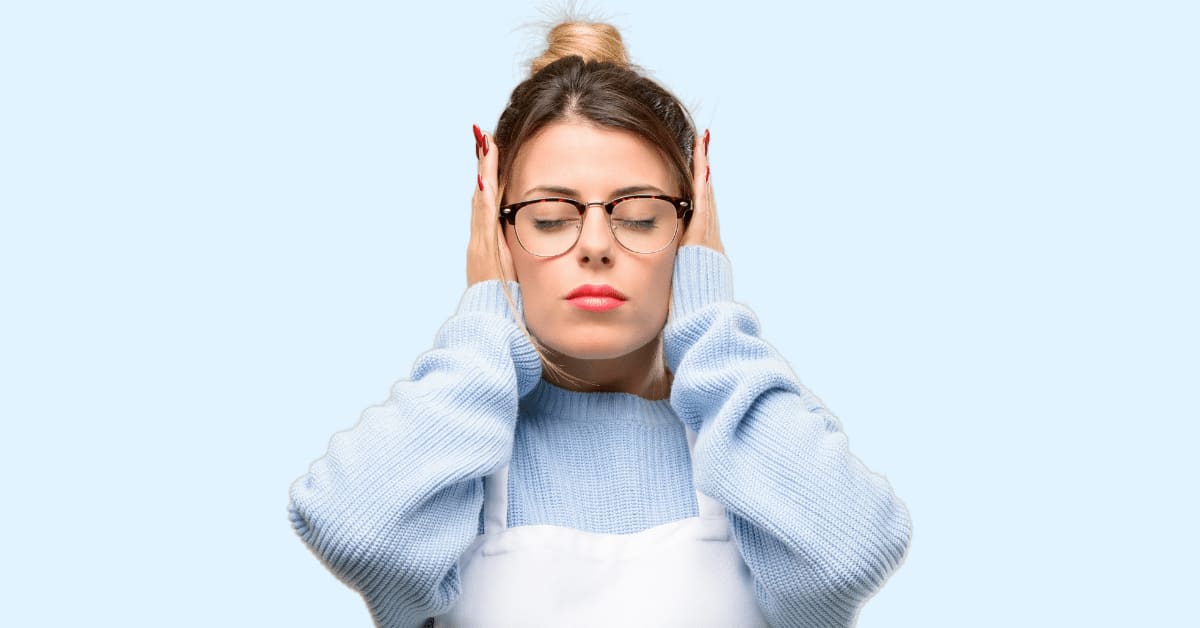
People with social anxiety typically engage in the following behaviors.
- Avoidance of the Feared Social Situations When Possible
- Employing Safety Behaviors When Confronted With Feared Situation (planning what to say before the event, checking the phone to not feel awkward, etc.)
- Worrying About Future Situations (Anticipatory Anxiety)
- Excessive Dwelling About Past Situations (Post-Event Processing)
During treatment, the patient is educated about the negative effects of these habits and is should aim to reduce or eliminate them.
Social Anxiety & Additional Problems
Even though there are many people who suffer solely from social anxiety, it has been pointed out that SAD often comes along with other mental health problems, such as substance use or depression (Schneier, Johnson, Hornig, Liebowitz, & Weissman, 1992).
Some people may consume alcohol or marijuana to decrease their social anxiety symptoms. This can result in adding another layer to the problem and making it even harder to address the primary problem: social anxiety disorder.
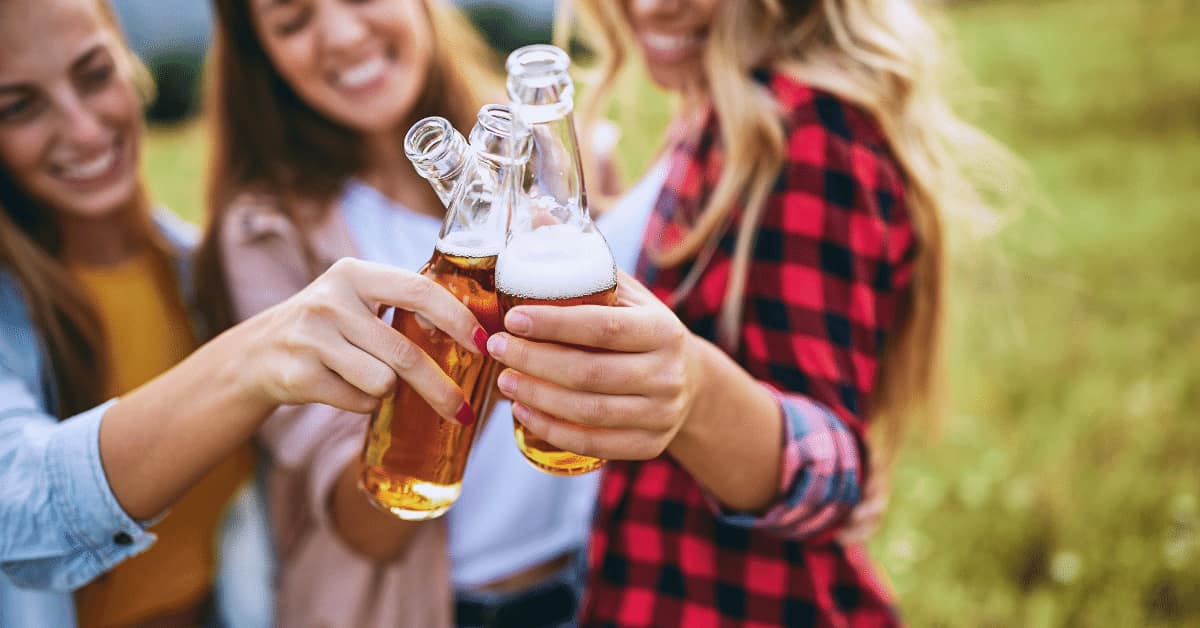
Social anxiety frequently comes along with the following disorders:
- mood disorders, such as major depression and bipolar disorder
- other anxiety disorders, such as generalized anxiety and panic disorder
- personality disorders, such as conduct disorder and avoidant personality disorder
- substance use disorders, such as alcohol and cannabis abuse
If a person suffers from additional disorders, these should be identified and properly addressed during treatment.
Do You Suffer From Social Anxiety Or Is It Something Else?
Also, some people may think they suffer from social anxiety, when in reality they are struggling with another, albeit similar, disorder.
Due to a strong overlap of their symptoms, this often leads to confusion and makes it hard to differentiate between social anxiety and similar psychological disorders.
Below, you can find the official diagnostic criteria and you can take one of the most applied social anxiety tests.
Disclaimer: For a real diagnosis you should always consult with your professional mental health care provider.

Social Anxiety Disorder DSM-5 Diagnosis
SAD was officially recognized as a psychological disorder in 1980. Since then, the Diagnostic and Statistical Manual of Mental Disorders (DSM) has changed the diagnostic criteria several times.
According to the American Psychiatric Association (APA, 2013), the current social anxiety disorder DSM-5 diagnostic criteria are defined as follows:
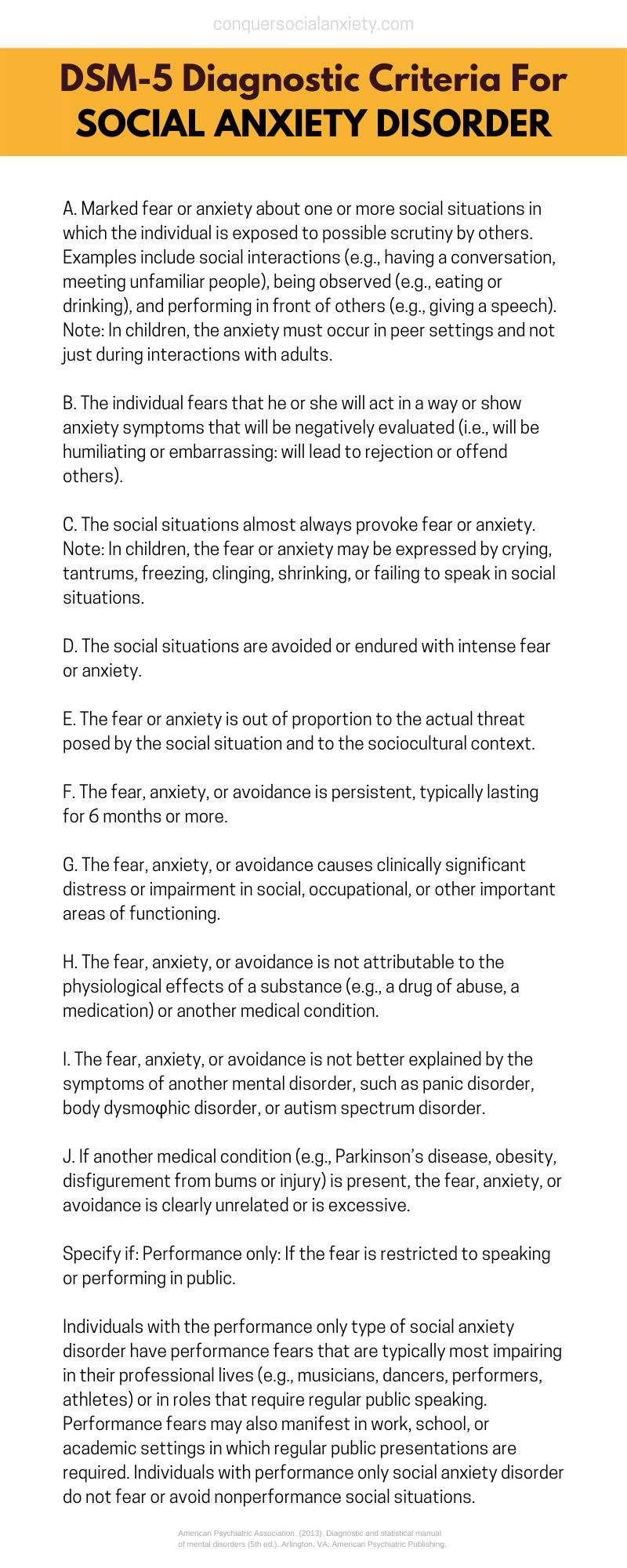
Take The Social Anxiety Test
By now, you should have a basic understanding of what it means to suffer from social anxiety. However, you might still be wondering whether or not you are affected.
While an official diagnosis should always be administered by a qualified mental health professional in person, there are several free social anxiety tests you can take online to get a good idea about your situation.

Note that not all tests that screen for social anxiety symptoms have been designed by professionals. Therefore, we caution to take results obtained in such questionnaires too seriously.
The following questionnaire has been professionally designed, approved and applied all over the world to test for social anxiety disorder.
Take self-report version of the Liebowitz Social Anxiety Scale, which measures SAD in teenagers and adults.

American Psychiatric Association. (2013). Diagnostic and statistical manual of mental disorders (5th ed.). Arlington, VA: American Psychiatric Publishing.
Anxiety and Depression Association of America. (n.d.). Understand the facts: Social anxiety disorder. Retrieved from https://adaa.org/understanding-anxiety/social-anxiety-disorder
Clark, D. M., & Wells, A. (1995). A cognitive model of social phobia. Social Phobia: Diagnosis, Assessment, and Treatment. https://doi.org/10.1016/S0005-7967(97)00022-3
Cox, B. J., Clara, I. P., Sareen, J., & Stein, M. B. (2008). The structure of feared social situations among individuals with a lifetime diagnosis of social anxiety disorder in two independent nationally representative mental health surveys. Behaviour Research and Therapy. https://doi.org/10.1016/j.brat.2008.01.011
Eng, W., Heimberg, R. G., Coles, M. E., Schneier, F. R., & Liebowitz, M. R. (2000). An empirical approach to subtype identification in individuals with social phobia. Psychological Medicine. https://doi.org/10.1017/S0033291799002895
Gilbert, P. (2001). Evolution and social anxiety: The role of attraction, social competition, and social hierarchies. Psychiatric Clinics of North America. https://doi.org/10.1016/S0193-953X(05)70260-4
Gilbert, P. (2014). Evolutionary models: practical and conceptual utility for the treatment and study of social anxiety disorder. In The Wiley Blackwell Handbook of Social Anxiety Disorder.
Hofmann, S. G. (2007). Cognitive factors that maintain social anxiety disorder: A comprehensive model and its treatment implications. Cognitive Behaviour Therapy. https://doi.org/10.1080/16506070701421313
Leary, M. R., & Jongman-Sereno, K. P. (2014). Social Anxiety as an Early Warning System: A Refinement and Extension of the Self-Presentation Theory of Social Anxiety. In Social Anxiety: Clinical, Developmental, and Social Perspectives: Third Edition. https://doi.org/10.1016/B978-0-12-394427-6.00020-0
Moscovitch, D. A. (2009). What Is the Core Fear in Social Phobia? A New Model to Facilitate Individualized Case Conceptualization and Treatment. Cognitive and Behavioral Practice. https://doi.org/10.1016/j.cbpra.2008.04.002
Rapee, R. M., & Heimberg, R. G. (1997). A cognitive-behavioral model of anxiety in social phobia. Behaviour Research and Therapy. https://doi.org/10.1016/S0005-7967(97)00022-3
Schneier, F. R., Johnson, J., Hornig, C. D., Liebowitz, M. R., & Weissman, M. M. (1992). Social Phobia: Comorbidity and Morbidity in an Epidemiologic Sample. Archives of General Psychiatry. . 01820040034004
Wegner, D. M. (1997). When the antidote is the poison: Ironic mental control processes. Psychological Science, 8(3), 148-150.
Wong, J., Gordon, E. A., & Heimberg, R. G. (2014). Cognitive-Behavioral Models of Social Anxiety Disorder. The Wiley Blackwell Handbook of Social Anxiety Disorder.
Share & Follow
[DISPLAY_ULTIMATE_SOCIAL_ICONS]
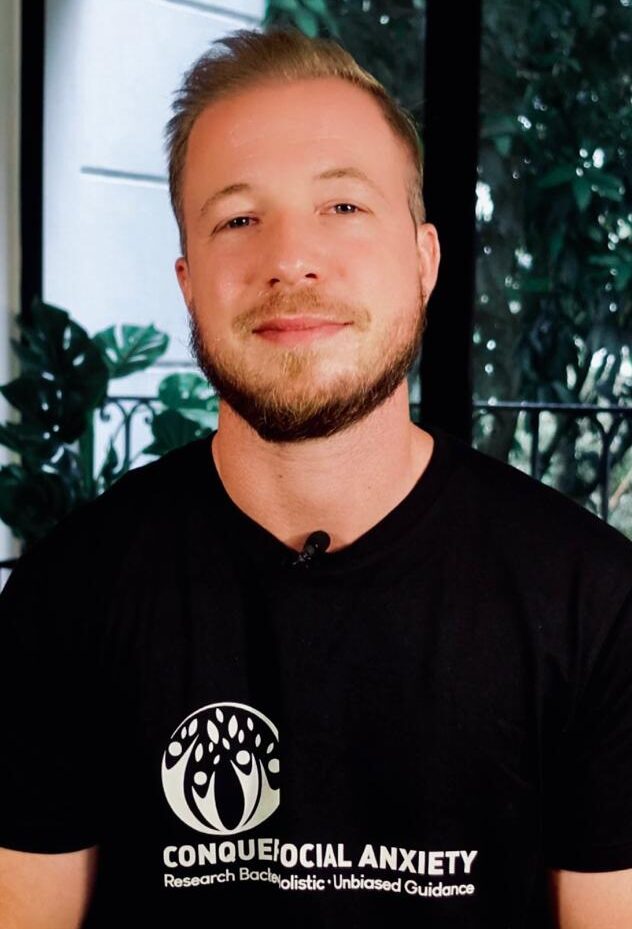
About the Author: Martin Stork
Martin is a professional psychologist with a background in physical therapy. He has organized and led various support groups for people with social anxiety in Washington, DC and Buenos Aires, Argentina. He is the founder of Conquer Social Anxiety Ltd, where he operates as a writer, therapist and director. You can click here to find out more about Martin.

